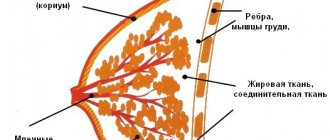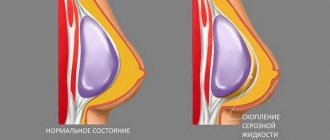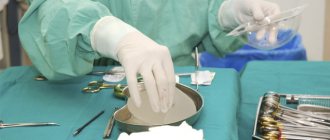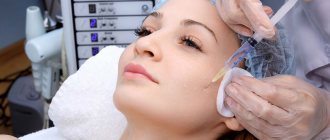Breast augmentation is one of the most popular plastic surgeries among women and can be performed for aesthetic reasons or for medical reasons. There are various methods of breast enlargement, both surgical and non-surgical.
Breast augmentation, as a surgical operation, takes little time, and with sufficient experience and high qualifications of the plastic surgeon, it is a safe and low-traumatic intervention.
About a million such operations are performed around the world every year, and the demand for surgical breast augmentation is growing every year. This is explained by the fact that modern technologies make it possible to change breast size quickly, practically painlessly and without long-term rehabilitation.
Breast implants have improved so much over the past few years that when installed correctly, even a specialist cannot always visually identify surgically enlarged breasts.
Among all the known types of breast enlargement (hormonal drugs - creams and tablets, physical exercises, vacuum massage, injections of fillers and own fat), the most popular and effective method is endoprosthetics. In addition, breast augmentation with implants is the only officially approved and approved method throughout the world.
Modern breast endoprostheses (silicone implants with gel content) are extremely safe, durable and have a huge variety of shapes, structures and sizes.
The most popular are round, teardrop-shaped and anatomical implants with a textured surface, which, unlike a smooth one, does not cause fibrotic changes in the gland.
Well-known global manufacturers of silicone implants guarantee the lifelong quality of their products. Numerous tests and studies confirm that breast replacement with progressive and high-quality implants does not cause rejection by the body and the development of oncological, immune and other diseases.
At the same time, a professionally and successfully performed mammoplasty operation can change the life of any woman for the better, improve many aspects of her personal life and psycho-emotional state.
What tests will be required before mammoplasty?
Before the operation, the patient must undergo a complete medical examination to identify general health and possible contraindications. The list of standard preoperative studies includes:
- General blood analysis.
- Biochemical blood test (total protein, ALT, AST, total bilirubin, creatinine, urea, glucose, electrolytes).
- General urine analysis.
- Analysis for blood group and Rh factor.
- Blood test for HIV, syphilis and hepatitis B and C (HBsAg, HCV).
- Blood test for coagulogram (blood clotting).
- Analysis for class E immunoglobulins to identify predisposition to allergic reactions in order to correctly select anesthesia.
- Analysis of hormonal levels to prevent implant rejection.
- ECG.
- Fluorography.
- Ultrasound of the mammary glands.
The therapist gives a conclusion about readiness for surgery. To prepare for anesthesia, you will need to visit an anesthesiologist.
If the surgeon doubts the condition of the mammary glands, the patient is sent for a consultation with a mammologist to examine the breasts for mastopathy, cysts, oncology and other pathological conditions that require preliminary treatment. The doctor may prescribe additional diagnostic procedures, such as mammography.
How is breast augmentation surgery performed?
After the necessary examination and consultations with specialists, the examination is carried out directly by the plastic surgeon who will perform the operation. First, the doctor, together with the patient, determines the optimal size and shape of the future breast and selects the appropriate implants.
For this purpose, special external endoprostheses (sizers) are often used, with the help of which you can imagine the final result of the operation and evaluate how natural and harmonious the new breast will look.
After the implants have been selected, all the details of the upcoming operation have been discussed and the necessary preoperative preparation has been completed, the time for the procedure is set.
Surgical breast augmentation surgery is carried out only in a hospital setting, in specially equipped operating rooms and with the participation of highly qualified specialists, including anesthesiologists.
Breast augmentation surgery is performed using general anesthesia and takes 1.5-3 hours. The main goal of augmentation mammoplasty is to create an anatomically correct and natural shape of the enlarged mammary gland, with a natural contour. Nothing should give away the fact of surgical intervention.
Prohibitions before surgery
- A month before surgery, you need to stop taking certain medications and even vitamin-mineral complexes. Some of them have a bad effect on healing and scarring. This is especially true for dietary supplements with vitamin E.
- For 2 weeks you need to stop taking glucocorticosteroids and oral contraceptives.
- For two weeks, drugs that reduce blood clotting, such as Aspirin, are eliminated.
- It is necessary to exclude non-steroidal anti-inflammatory drugs (Ibuprofen, etc.), because they affect the speed of blood flow and the walls of blood vessels.
- Be sure to eliminate alcohol and smoking for 1 month.
Recovery period
The rehabilitation period after breast augmentation is not difficult or long. After about 1-3 days, the patient can return home, following special medical recommendations. Pain and swelling in the chest area may persist for several days, so painkillers are sometimes recommended.
The surgeon removes the sutures after 1-1.5 weeks.
After the operation, the following conditions must be met:
- using chest compression garments for several weeks;
- a gentle physical regimen - excluding sports, running, lifting weights, limiting arm movements.
Recommendations after mammoplasty
What to expect the first time after surgery?
On the first day, a drainage will be installed in the chest, which drains serous-hemorrhagic fluid. Compression garments are placed on the bust and will need to be worn for two months. It records the result. During this period, the breasts are swollen, hard to the touch, and unusually high. Bruising may occur. The pain syndrome is relieved with special drugs that are administered intravenously while the patient is in the hospital.
In the early postoperative period, it is prohibited to raise your arms above your shoulders, as well as objects weighing more than 5 kg. It is necessary to avoid sudden movements and do not open doors yourself.
How is the rehabilitation going?
The patient is in the hospital for 1-2 days; bed rest is indicated on the first day. At home, you should continue to take the antibiotics prescribed by your doctor and wash your sutures. You should definitely wear compression garments; they fix the new shape of your breasts. In the first 3-5 days, discomfort and pain are possible, so the doctor prescribes a painkiller.
On days 10-12, the stitches are removed, but it is too early to evaluate the result, because bruises and swelling persist. In the first two weeks, you should not play sports, take a hot shower or bath, or lift weights.
Full recovery occurs after 6 months, during which time all restrictions are gradually lifted.
General recommendations after breast surgery
- Give up sports for 6 months. Some sports cannot be resumed forever.
- Avoid baths and saunas for 2 months. In the future, ensure that the temperature in the steam room does not exceed +100 C.
- Plan pregnancy at least 6 months after surgery.
- Driving is not recommended because it puts stress on the pectoral muscles. Also, do not squeeze your bust with a seat belt.
- In the first 2-3 weeks you need to sleep on your back.
- Avoid intimacy for a month.
- Avoid intense tanning and solariums for 6-12 months.
- Avoid hot baths for 6-8 weeks.
- Do not swim in the sea or pool for 2-3 months.
- Do not smoke or drink alcohol for 2-4 weeks.
Result of breast augmentation surgery
The success of plastic surgery on the mammary glands primarily depends on the experience and skill of the surgeon and is determined by the aesthetics and naturalness of the final result: the more natural the breasts look, the higher the quality of the work performed.
The first results of the operation can be assessed after 2-3 months, when the swelling subsides and the muscles and breast tissue are evenly distributed around the implant. Healing of thread-like postoperative scars occurs in about six months to a year; they become almost invisible in the natural folds of the skin.
However, you should not think that ideal breasts will last for the rest of your life. Unfortunately, over time, the mammary glands will undergo age-related changes, like the rest of the body; breast tissue may sag, a decrease in volume, therefore, after 15-20 years, a repeat operation will most likely be required.
Reviews about breast augmentation
Most women who have had their breasts enlarged surgically are satisfied with the results. Positive or negative reviews about breast augmentation depend on how successful the mammoplasty was.
Fortunately, complications or unsuccessful operations are extremely rare, and are mainly the result of visiting cheap, poorly equipped medical centers, inexperienced surgeons, and often using low-quality or outdated implant models.
In prestigious and well-established clinics with highly qualified specialists on their staff, the results of mammoplasty are more than satisfactory.
Surgical breast augmentation operations, which have proven their effectiveness and safety all over the world, are becoming more common and popular. However, we should not forget that this is still a serious surgical intervention that cannot be performed as an ordinary medical procedure in the nearest medical facility.
Breast augmentation requires careful decision-making and careful professional preparation, otherwise it may result in unpleasant consequences.
What is mammoplasty, its types
More and more women are turning to clinics for breast correction. Mammoplasty is a promising area of plastic surgery that is constantly evolving.
Depending on the final result, there are four types of corrective operations:
- Breast lift - mastopexy.
- Reduction in volume – reduction of the mammary glands.
- Argumentative plastic surgery – increasing breast size using an implant.
- Plastic surgery for nipple correction (areola).
Breast lift using liposuction
This is another method that is aimed at reducing breast size. The duration of such an operation, as a rule, is no more than 1.5 hours. During this procedure, several punctures are made along the contour of the bust and fat is suctioned using special tubes. The diameter of such tubes ranges from 2 to 7 millimeters. They are connected to a vacuum pump and injected into areas of fat accumulation.
It is worth noting that such an operation has practically no complications, but it is recommended to be performed after the birth of children .
After the procedure, postoperative swelling disappears within 2 weeks, but compression garments must be worn for at least 3 weeks.
What you need to warn relatives about
As a rule, recovery after mammoplasty is not protracted or difficult. The client will be discharged home on the second day after the operation.
Before that, she will need to tell her family how to behave:
- try not to disturb the woman during the recovery period. She needs peace, healthy sleep and care;
- tell that mammoplasty is a safe and popular operation that will not cause harm, on the contrary, it will only improve the quality of life. Perhaps it will be easier for relatives if they help them choose a clinic and a specialist doctor;
- You may need help getting dressed for some time;
- Psychological support is very important. The good mood of family and friends is transmitted to the patient and helps to recover quickly;
- everything that surrounds a woman after surgery must be adapted so that she can use it comfortably. We'll have to rearrange some things and move furniture.
The support of family and friends, their care and concern are necessary after any medical intervention.
What you need to know about implants
In modern clinics, two types of endoprostheses (implants) are used:
- with helium filler,
- with filler in the form of saline solution - 9% saline solution.
The outer shell material in both cases is silicone. The structure of the silicone shell is of two types: smooth, textured. The disadvantage of smooth endoprostheses is the high probability of displacement. Other types of implants have a low probability of displacement, but the percentage of their overgrowth with internal connective tissue is high.
Due to the growth of connective tissue, unsightly folds may appear on the skin.
The rupture of a saline implant causes less harm to health. The advantage of such models is their relatively low price, the disadvantage is the squelching effect while driving. Helium-filled endoprostheses are more elastic, do not lose shape when the shell ruptures, and can cause breast sagging over time.
Implants can be selected according to their shape. Clinics offer round and anatomical endoprostheses. Round ones guarantee symmetry and a constant shape, while anatomical ones (drop-shaped) guarantee a natural appearance of the breast.
For women with small breasts, the anatomical option is usually recommended; for those with large and saggy breasts, round-shaped implants are recommended.
In any case, the clinic specialist analyzes the anatomical structure of the client and offers the most optimal option.
Size matters; the larger the size, the higher the weight of the implant. The relationship between size and weight is direct. The size of the implant is calculated by the volume of the filler. The first size is equal to the volume of 150 ml, the second, respectively, 300 ml. All subsequent sizes increase the weight significantly. The surgeon can make adjustments to the client’s wishes based on the characteristics of her figure:
- width of the chest,
- skin structure, its density,
- proportions of all parts of the body.
How to prevent complications
The development of complications is a direct consequence of the fact that the instructions of the attending physician were not followed and proper care was not provided to the client.
To prevent this from happening, you need to:
- Before surgery, remove makeup and wash your body thoroughly;
- after surgery, reduce physical activity and stop going to the gym;
- do not drink or smoke for at least three months after mammoplasty;
- ensure sufficient sleep and rest;
- do not use painkillers that thin the blood and impede recovery, as well as medications containing aspirin;
- protect yourself from stress and anxiety
Remember that surgery will bring about miraculous changes. Discomfort during recovery is a low price to pay for self-confidence and beauty!
For what conditions is breast surgery indicated?
- Changes in the mammary glands that appear during the maturation of the female body Hypomastia is insufficient development of the volume of the mammary glands.
- Hypertrophy (gigantomastia) is excessive development of mammary gland tissue.
- Asymmetries in the development of mammary glands.
- Formation of an atypical shape of the mammary glands: tubular, crescentic, pear-shaped, etc.
- Mastoptosis is prolapse of the mammary glands not associated with pregnancy and lactation.
- Postlactation involution is the resorption of mammary gland tissue.
- Amastia is a congenital absence of the mammary gland.
Psychological attitude
Many people are afraid of surgery, they are afraid of the consequences of anesthesia, of an unsuccessful operation. For some, the thought of a long, painful recovery makes them uncomfortable.
Such anxiety has a very negative impact on the body. You need to feel good physically and mentally before going for mammoplasty.
It is important to remember:
- what advantages the operation will give;
- how many external and internal psychological problems will it solve;
- how many opportunities for the joys of life a new, beautiful breast will give.
Find out what the price of mammoplasty is.
What do complications of unsuccessful mammoplasty look like? Read on.
When will breasts shrink after mammoplasty? See more details.











